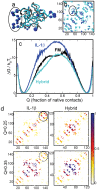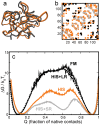Understanding the folding-function tradeoff in proteins
- PMID: 23593437
- PMCID: PMC3625163
- DOI: 10.1371/journal.pone.0061222
Understanding the folding-function tradeoff in proteins
Abstract
When an amino-acid sequence cannot be optimized for both folding and function, folding can get compromised in favor of function. To understand this tradeoff better, we devise a novel method for extracting the "function-less" folding-motif of a protein fold from a set of structurally similar but functionally diverse proteins. We then obtain the β-trefoil folding-motif, and study its folding using structure-based models and molecular dynamics simulations. CompariA protein sequence serves two purpson with the folding of wild-type β-trefoil proteins shows that function affects folding in two ways: In the slower folding interleukin-1β, binding sites make the fold more complex, increase contact order and slow folding. In the faster folding hisactophilin, residues which could have been part of the folding-motif are used for function. This reduces the density of native contacts in functional regions and increases folding rate. The folding-motif helps identify subtle structural deviations which perturb folding. These may then be used for functional annotation. Further, the folding-motif could potentially be used as a first step in the sequence design of function-less scaffold proteins. Desired function can then be engineered into these scaffolds.
Conflict of interest statement
Figures








Similar articles
-
Structural Perturbations Present in the Folding Cores of Interleukin-33 and Interleukin-1β Correlate to Differences in Their Function.J Phys Chem B. 2015 Aug 27;119(34):11203-14. doi: 10.1021/acs.jpcb.5b03111. Epub 2015 Jun 23. J Phys Chem B. 2015. PMID: 26061905
-
Conserved and nonconserved features of the folding pathway of hisactophilin, a beta-trefoil protein.Protein Sci. 2002 Mar;11(3):669-79. doi: 10.1110/ps.31702. Protein Sci. 2002. PMID: 11847289 Free PMC article.
-
Contact pair dynamics during folding of two small proteins: chicken villin head piece and the Alzheimer protein beta-amyloid.J Chem Phys. 2004 Jan 15;120(3):1602-12. doi: 10.1063/1.1633253. J Chem Phys. 2004. PMID: 15268287
-
Using the folding landscapes of proteins to understand protein function.Curr Opin Struct Biol. 2016 Feb;36:67-74. doi: 10.1016/j.sbi.2016.01.001. Epub 2016 Jan 24. Curr Opin Struct Biol. 2016. PMID: 26812092 Review.
-
Ultrafast and downhill protein folding.Curr Opin Struct Biol. 2007 Feb;17(1):38-47. doi: 10.1016/j.sbi.2007.01.001. Epub 2007 Jan 12. Curr Opin Struct Biol. 2007. PMID: 17223539 Review.
Cited by
-
Engineering the kinetic stability of a β-trefoil protein by tuning its topological complexity.Front Mol Biosci. 2023 Feb 8;10:1021733. doi: 10.3389/fmolb.2023.1021733. eCollection 2023. Front Mol Biosci. 2023. PMID: 36845544 Free PMC article.
-
Altered backbone and side-chain interactions result in route heterogeneity during the folding of interleukin-1β (IL-1β).Biophys J. 2013 Aug 20;105(4):975-83. doi: 10.1016/j.bpj.2013.06.019. Biophys J. 2013. PMID: 23972849 Free PMC article.
-
Protein misfolding involving entanglements providesa structural explanation for the origin of stretched-exponential refolding kinetics.Sci Adv. 2025 Mar 14;11(11):eads7379. doi: 10.1126/sciadv.ads7379. Epub 2025 Mar 14. Sci Adv. 2025. PMID: 40085700 Free PMC article.
-
Cooperative hydrophobic core interactions in the β-trefoil architecture.Protein Sci. 2021 May;30(5):956-965. doi: 10.1002/pro.4059. Epub 2021 Mar 16. Protein Sci. 2021. PMID: 33686691 Free PMC article.
-
Functionalization of a symmetric protein scaffold: Redundant folding nuclei and alternative oligomeric folding pathways.Protein Sci. 2022 May;31(5):e4301. doi: 10.1002/pro.4301. Protein Sci. 2022. PMID: 35481645 Free PMC article.
References
-
- Kloczkowski A, Sen TZ, Jernigan RL (2005) Promiscuous vs. native protein function. Insights from studying collective motions in proteins with elastic network models. J Biomol Struct Dyn 22: 621–624 and references therein.
-
- Frauenfelder H, Sligar SG, Wolynes PG (1991) The energy landscapes and motions of proteins. Science 254: 1598–1603. - PubMed
Publication types
MeSH terms
Substances
LinkOut - more resources
Full Text Sources
Other Literature Sources

